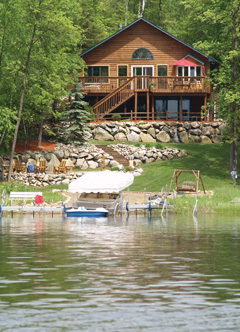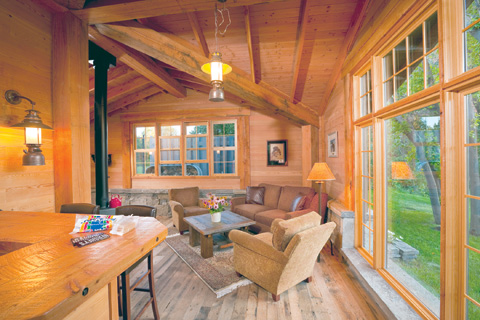Global thinking, seeing the project in its entirety, is critical to cost-effective log home construction. Every aspect of a log home project requires planning and foresight and an eye for the practical and aesthetic with cost containment always in mind.
Simply getting started is a challenge in itself. But Chris Wood, vice president of sales at Hearthstone Homes, sees opportunity in the basic design of the log home. “Keep it simple,” he offers. “Straight roof lines, a rectangular footprint, level site, short driveway, stock cabinetry, and managing your allowances. Of course, we don’t see these decisions trending often!”
Moving toward specialties does indeed promise to drive up construction costs. Basic is better. Allowances are allocations of the construction budget for specific components. Spending above allowances either means more out of pocket or a return visit to your lender, hat in hand, to ask for more money. Change orders can easily spiral out of control.
“A great way to save is building ‘up’ rather than ‘out,’” adds Mark Wrightman, marketing manager at True North Log Homes. “If you require 3,000 square feet of floor area in your home, it will be less expensive to have 2,000 square feet on the main floor and 1,000 square feet in a loft or second floor than to build 3,000 square feet on the main floor. Every time you increase your main floor by a square foot, you have increased the roof and foundation square footage as well. By increasing the roof truss height and adding a floor system you have accessed extra square footage without adding foundation or extra roof structure.”
When it comes to building materials, those in the log home construction business agree. Simply put, you get what you pay for. “Avoid deals on aged inventory unless you visually inspect it first,” notes Wood, “and increase the waste factor for it. Group your buying power to one source and negotiate the best price available.”
Wrightman’s experience reveals that the low cost materials provider is often the low quality materials provider as well. Saving money in the short run will probably cost money in the years to come. True North offers a pre-staining service that machine coats interior and exterior wood components before they are shipped from the factory, reducing labor costs and time.

iStock.com/Nelsonarts
“Planning saves money,” declares Jock Davidson, owner of Kozy Log Cabins. “On-sale items that you know you will have to have, particularly interior things like lighting and plumbing fixtures, finished flooring, cabinets, and vanities, purchase and store them until you are ready for them. Start now.”
One of the biggest expenses in any log home construction undertaking is labor. When workers are on the clock, they should be productive, and minimizing their downtime and travel expense can generate big savings. “Decide what you want to do yourself and avoid change orders,” comments Wood. “Minimize the number of trips to the job site by the labor force. A two-man crew traveling 45 minutes to the job site could cost $200 each trip.”
Saving money is a lifetime exercise. Wise spending today will continue to pay dividends tomorrow. Energy costs are liable to continue to rise. Consider environmentally friendly and efficient alternatives to traditional sources. “Upgrade your heating systems to in-floor heat with geothermal technology,” says Wrightman. “There are more expensive upfront costs, but lower heating costs long term. There are also lots of advancements in solar and geotechnology to assist in energy consumption.”
Wood says to avoid the “wall of glass” exposed to the south and west unless the roofline is extended for a covered porch or tinted glass is used. Additionally, complex rooflines are difficult to insulate. He recommends a blower test with thermal imaging before completing construction and using the results to foam and seal gaps that are an inevitable part of building a log home. Constructing a tight home is the first line of defense against energy waste.
Log home sites vary in topography, visual lines, and distance from roadways and utilities. While the view is usually the deciding factor, it sometimes comes with a hefty price tag. Positioning the log home on the lot may be a relatively inexpensive endeavor or add thousands of dollars to the bottom line.
“Saving money on the site is easy,” remarks Wightman. “Typically, if you use the same company for site preparation, excavation, backfill, driveway, and septic you can decrease your cost in floating charges and negotiate a better price with the installer. Using multiple companies increases costs most of the time as you pay for floating equipment in and out of the job site.”
Davidson encourages clients to be familiar with their home site and weigh the best options to keep preparation work at a minimum. “Select the terrain on which to build the home with an eye toward easier site preparation, foundation requirements, and home construction,” he advises. “A building site that is difficult to get to or with a bedrock terrain can make the project much more expensive than you might have anticipated. Take care with positioning the home on the site. Try to orient it to take advantage of natural warming and cooling and position it for maximum efficiency. Pay attention to wind and weather.”
Homeowners are sometimes stunned at the expense required to move earth, tap into gas lines or electricity, excavate, pave, or build walls to control the runoff of water on a site with a steep grade. “The farther off the road the job site is, the more it will cost for utility access and driveway expense. Sloping sites with views are wonderful, but $100,00 in retaining walls and foundation stone is often an unintended consequence.”
From beginning to end, the close management of the construction budget and taking advantage of prudent cost savings wherever possible will bring a project together with great results. Perhaps the best advice for those taking the big step is to remember that every dollar going into the house should serve a “constructive” purpose. Once spent, the wasted dollar is never recovered.

